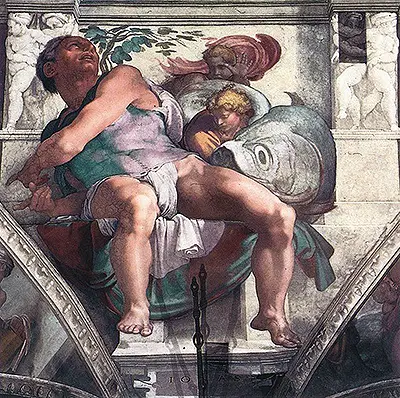This large painting, 390-cm x 380-cm, depicts the prophet Jonah from the Old Testament, reclining almost naked. With his head thrown back, Jonah appears to be looking up and drawing the attention of the viewer to the centre of the ceiling which is elaborately decorated with scenes of the Creation and the life of Noah.
Around the sides are another six prophets and five female Sibyls who draw attention back towards Jonah who represents the promise of Resurrection. Jonah the Prophet
Jonah is the largest of the Prophets and is accompanied by two cherubic figures and a large fish which is nibbling at his thigh. There is some mystery regarding why Michelangelo painted what appears to be a giant Tarpon; but it was only when the King James Version of the Bible was introduced in 1611, that the fish became the whale that we are familiar with in the story of Jonah and the Whale.
Michelangelo very cleverly squeezed this huge fresco into a limited space in the south end of the vaulted ceiling. The skilful use of perspective creates the illusion that Jonah is lying back, in spite of the fact that the ceiling is sloping forward. Jonah is situated directly above the Last Judgment, another fresco created by the same artist twenty years later.
Pope Julius the Second commissioned Michelangelo to decorate the twelve triangular areas above the windows with the twelve Apostles. The artist, being reluctant to take the job, as sculpting was his primary interest, persuaded the Pope to give him a free reign in the design. Instead, Michelangelo laid out his creation in nine panels within the architecture of the vaulting, depicting episodes from the book of Genesis.
Three panels represent the Creation; three with the stories of Adam and Eve; and three contain stories of Noah. Surrounding these panels are the seven Prophets, and five female Sibyls taken from classical myths.
Below this, there are small figures from forty generations of Christ’s ancestors going right back to Abraham.
Scaffolding was erected in the chapel, and Michelangelo spent four years working on this monumental creation. The scale and awe-inspiring beauty of Michelangelo’s painting, with the bright harmonising colours, coupled with his clever use of chiaroscuro Michelangelo created, over four years, what is considered to be the finest example of Renaissance art ever, and he is appraised as the most famous western artist in history.
High Renaissance art is composed of Catholic religious scenes and Greek mythology. The religious theme is clearly evident in The Creation of Adam; possibly the most recognised and reproduced of Michelangelo’s frescoes. The Christian message is strong despite the pagan undertones in Michelangelo’s paintings. Michelangelo liked to show off his detailed knowledge of the human body and a lot of his artwork portrayed nude or semi-nude figures.
The importance of the Sistine Chapel in the history of modern western art cannot be denied. To the present day, it has become something of a 'Mecca' for students and professionals alike. Controversially, the frescoes of the Sistine Chapel underwent refurbishment recently, which revitalised the colours and fine details of these iconic artworks five hundred years after they were created.


